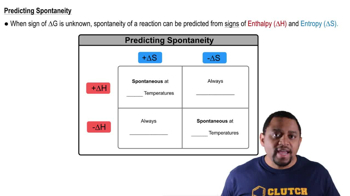The potassium-ion concentration in blood plasma is about 5.0⨉10-3 M, whereas the concentration in muscle-cell fluid is much greater (0.15 M ). The plasma and intracellular fluid are separated by the cell membrane, which we assume is permeable only to K+. (a) What is ΔG for the transfer of 1 mol of K+ from blood plasma to the cellular fluid at body temperature 37 °C? (b) What is the minimum amount of work that must be used to transfer this K+?
Ch.19 - Chemical Thermodynamics
Chapter 19, Problem 105
At what temperatures is the following reaction, the reduction of magnetite by graphite to elemental iron, spontaneous? Fe3O4(s) + 2 C(s, graphite) → 2 CO2(g) + 3 Fe(s)
 Verified step by step guidance
Verified step by step guidance1
Identify the reaction and write it down in a balanced chemical equation format: \( \text{Fe}_3\text{O}_4(s) + 2\text{C}(s, \text{graphite}) \rightarrow 2\text{CO}_2(g) + 3\text{Fe}(s) \).
Determine the standard Gibbs free energy change (\( \Delta G^\circ \)) for the reaction using standard Gibbs free energies of formation for each compound involved in the reaction.
Use the equation \( \Delta G = \Delta G^\circ + RT \ln Q \) to relate the Gibbs free energy change at any temperature (T) and reaction quotient (Q). For spontaneity, \( \Delta G \) should be less than zero.
Since the reaction involves only solids and gases at standard state, the reaction quotient (Q) simplifies to 1 under standard conditions. Thus, the spontaneity depends solely on \( \Delta G^\circ \).
Calculate the temperature at which \( \Delta G^\circ \) changes sign using the relationship \( \Delta G^\circ = -RT \ln K \), where K is the equilibrium constant. The reaction is spontaneous at temperatures where \( \Delta G^\circ < 0 \).

Verified video answer for a similar problem:
This video solution was recommended by our tutors as helpful for the problem above.
Video duration:
7mWas this helpful?
Key Concepts
Here are the essential concepts you must grasp in order to answer the question correctly.
Gibbs Free Energy
Gibbs Free Energy (G) is a thermodynamic potential that helps predict the spontaneity of a reaction at constant temperature and pressure. A reaction is spontaneous when the change in Gibbs Free Energy (ΔG) is negative. The relationship between ΔG, enthalpy (ΔH), and entropy (ΔS) is given by the equation ΔG = ΔH - TΔS, where T is the temperature in Kelvin.
Recommended video:
Guided course

Gibbs Free Energy of Reactions
Entropy and Enthalpy
Entropy (S) is a measure of the disorder or randomness in a system, while enthalpy (H) is a measure of the total energy of a system, including internal energy and the energy required to make room for it. In the context of a reaction, an increase in entropy (positive ΔS) often favors spontaneity, especially at higher temperatures, while a decrease in enthalpy (negative ΔH) also promotes spontaneity.
Recommended video:
Guided course

Entropy in Thermodynamics
Temperature's Role in Spontaneity
Temperature plays a crucial role in determining the spontaneity of a reaction through its influence on the Gibbs Free Energy equation. As temperature increases, the TΔS term becomes more significant, which can make a reaction spontaneous if ΔS is positive. Therefore, understanding how temperature affects the balance between enthalpy and entropy is essential for predicting the spontaneity of the reduction of magnetite by graphite.
Recommended video:
Guided course

Spontaneity and Temperature
Related Practice
Textbook Question
Textbook Question
In chemical kinetics, the entropy of activation is the entropy change for the process in which the reactants reach the activated complex. Predict whether the entropy of activation for a bimolecular process is usually positive or negative.
Textbook Question
An ice cube with a mass of 20 g at -20 °C (typical freezer temperature) is dropped into a cup that holds 500 mL of hot water, initially at 83 °C. What is the final temperature in the cup? The density of liquid water is 1.00 g>mL; the specific heat capacity of ice is 2.03 J>g@C; the specific heat capacity of liquid water is 4.184 J>g@C; the enthalpy of fusion of water is 6.01 kJ>mol.
Textbook Question
Carbon disulfide 1CS22 is a toxic, highly flammable substance. The following thermodynamic data are available for CS21l2 and CS21g2 at 298 K: (e) Use the data in the table to calculate ΔS° at 298 K for the vaporization of CS21l2. Is the sign of ΔS° as you would expect for a vaporization?
